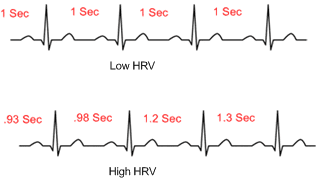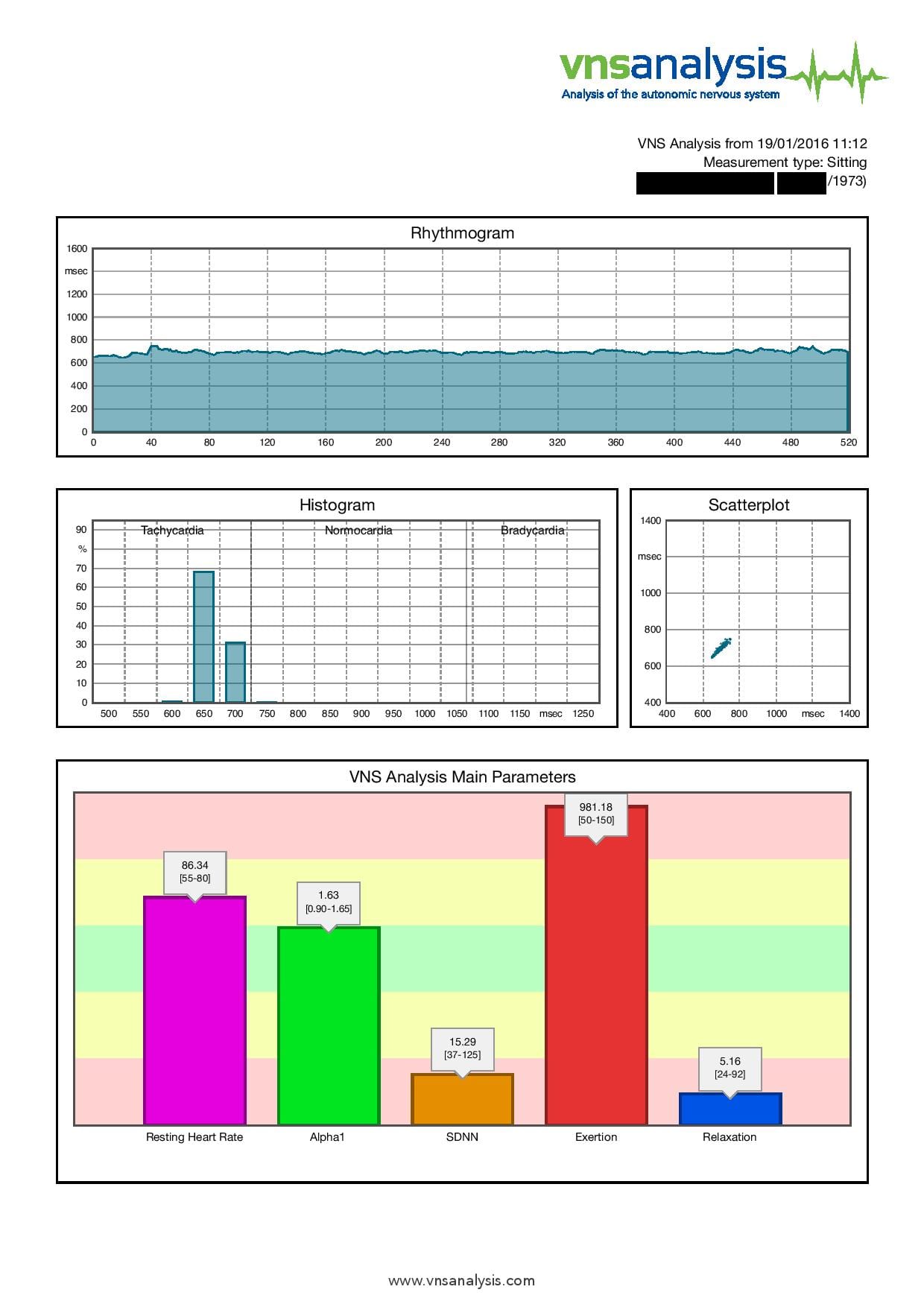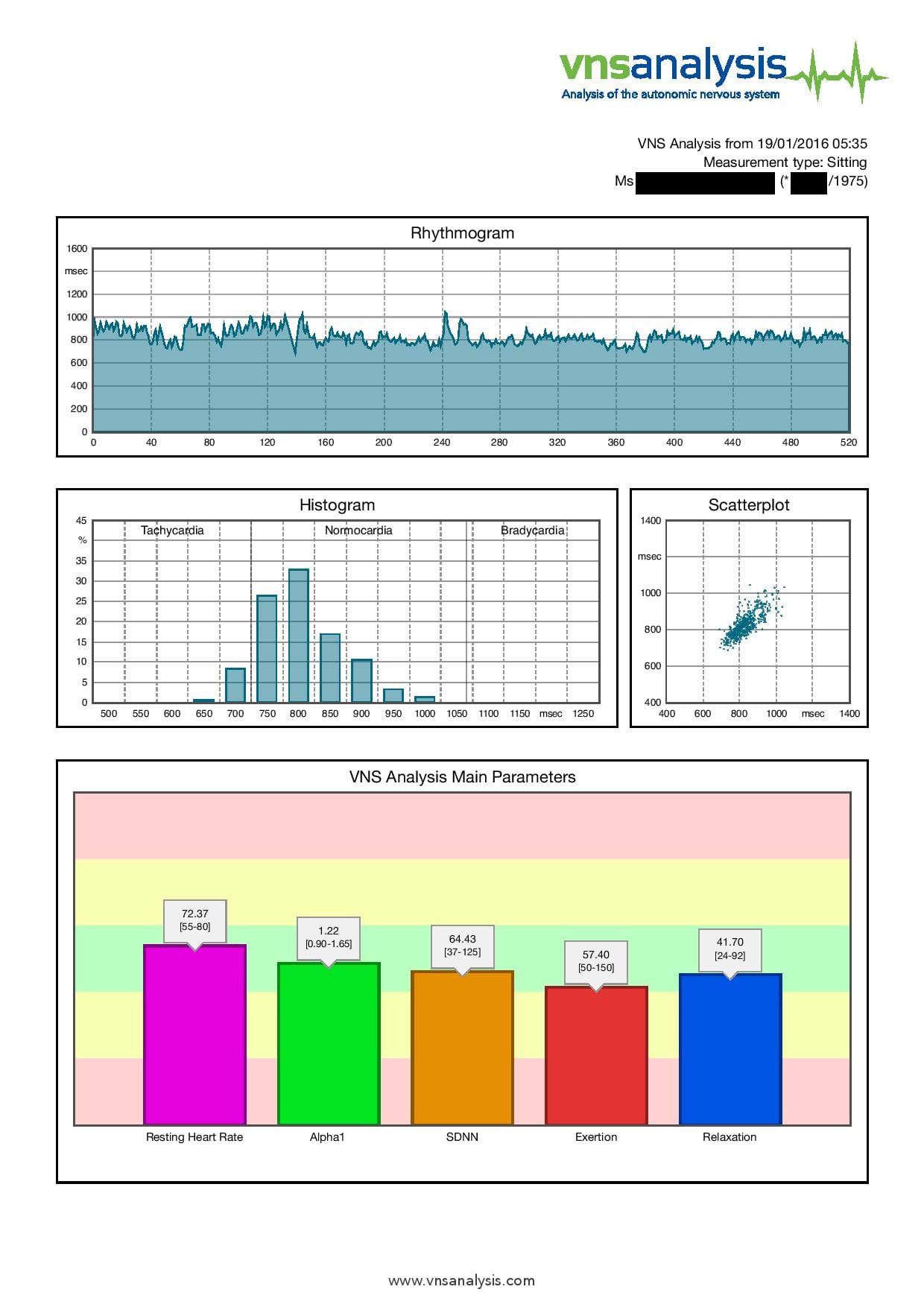ANS ANALYSIS
IT IS NOT THE STRONGEST NOR MOST INTELLIGENT SPECIES THAT SURVIVES, BUT THE ONE MOST ADAPTABLE TO CHANGE. – CHARLES DARWIN
IMPORTANT NOTE: The ANS Analysis is a scientifically validated assessment of the adaptability of the autonomic nervous system. It does not, however, constitute a medical diagnosis and should not be used as a substitute for medical care. Never disregard professional medical advice or delay in seeking it because of the ANS Analysis or something you have read on this website. If you have or suspect you may have a medical problem then you should consult your licensed medical doctor.
HEART RATE VARIABILITY: A POWERFUL MARKER OF HEALTH AND DISEASE
It is not the strongest nor most intelligent species that survives, but the one most adaptable to change.
– Charles Darwin
For years scientists and physicians have been searching for a biomarker to assess overall health and predict disease risk. Parameters such a total cholesterol, LDL-cholesterol, C-reactive protein, body mass index, and waist to hip ratio have all failed to deliver as broad indicators of overall health. Fortunately, however, one biomarker has stood the test of time and is now backed by nearly 20,000 studies which demonstrate its usefulness in detection of a wide range of illnesses. That biomarker is heart rate variability (HRV).
WHAT IS HRV?
HRV is a measurement of the beat-to-beat fluctuation in the function of the heart. Although common sense would say that a very regular heart rate with no beat-to-beat variation is a healthy thing, in actuality the opposite is the case. Subtle changes in the interval between heartbeats are an indication of adaptability and resilience within the system, meaning that the nervous system is able to adjust readily to the fluctuating demands of the internal and external environments. On the other hand, a low HRV score indicates an increased risk of numerous disease states and suggests an overall picture of high stress and poor health.

WHAT DOES HRV TELL US?
In general, high HRV indicates dominance of the parasympathetic (or rest and digest) nervous system, while low HRV indicates a nervous system that is stuck in fight-or-flight mode or sympathetic dominance (see below for more information about the sympathetic and parasympathetic nervous systems). Interestingly enough, ancient masters of Chinese pulse diagnosis understood that a too-regular heartbeat is unhealthy. Over 1700 years ago, the third-century physician Wang Shu-he stated in The Knowledge of Pulse Diagnosis:
“If the heartbeat gets as regular as the knocking of the woodpecker or the dripping of the rain on the roof, the patient will die within four days.”
HRV TESTING NOW AVAILABLE IN WACO
Because I have found the scientific literature regarding HRV so compelling, I have partnered with a German software company to bring the ANS Analysis system to Waco. A complimentary ANS Analysis is available upon request at new patient consultations and follow-up analyses are available for $35.00 each. The manufacturer suggests follow up analysis on a monthly basis (or anytime there has been a significant change in condition) for patients undergoing active acupuncture treatment. Once or twice yearly monitoring is recommended for everyone else.
LOW HEART RATE VARIABILITY
A stressed, unhealthy, or exhausted autonomic nervous system is not adaptable. This is evident when the heart beats in a very regular, robotic fashion, like a formation of solders marching. Low HRV is associated with the development of coronary heart disease and Syndrome X (diabetes, hypertension, high cholesterol) and is often evident in people who’ve had heart attacks. Following a heart attack, patients with low HRV are at a higher risk of dying in the subsequent three years. Low heart rate variability is associated with depression, anxiety, and aggression.

HIGH HEART RATE VARIABILITY
A healthy autonomic nervous system is constantly adapting and responding to the environment. It behaves like a happy dog gallivanting through the woods, slowing to sniff something on the ground here, then jogging to catch up with its companions there, always relaxed and responsive. High heart rate variability is associated with relaxed mood, rapid recovery from illness and disease, and “healthy longevity” — the kind of graceful aging we all desire.

HOW DOES ANS ANALYSIS WORK?
The Autonomic Nervous System (ANS) Analysis is based on the detection and subsequent interpretation of 520 heartbeats (depending on pulse, between 5 -10 minutes) by means of a Bluetooth chest strap. Data from the chest strap is transmitted digitally and wirelessly to the iPad, where the ANS Analysis software calculates the main ANS parameters automatically. The ANS Analysis report depict HRV in four different ways (see below for two examples of ANS Analysis reports).
Rhythmogram
The rhythmogram shows how the heart rate fluctuates over the course of the 520 beat recording period. In the rhythmogram below on the left, you see almost no variability. The illustration is similar to a straight line. This means that the heart is working at full capacity all the time and the autonomic nervous system is not adaptable. In the rhythmogram on the right, there is a lot of up and down variation, which shows that the autonomic nervous system is constantly adjusting so that the heart only has to work as hard as is needed to meet demand as they change on a moment to moment basis.
Histogram
In the histogram, the individual time values are broken down into defined time domains, e.g. 900 – 950 ms, etc. The frequency of readings (in percent) within a particular time domain is depicted by the height of the bars. The variability of the cardiac rhythm, and hence the variability of ANS regulation, increases with the number of bars found across the width of the chart. Only two bars indicate that the RR intervals are almost identical. This suggests that the heart is working at full capacity to be highly productive and is not adapting. In contrast, the histogram on the right shows a large distribution of bars across the width of the chart. Ideally this distribution should resemble a bell-shaped curve.
Scatterplot
The scatter cloud depicts the same data in a different way, with a large scatter cloud indicating greater cardiac rhythm variability and thus better ANS regulation. A condensed cloud indicates the heart is beating in an uniform rhythm with low HRV.
VNS Analysis Main Parameters
(Note that the report uses the acronym VNS as opposed to ANS. This is because the software manufacturer is German, and in German the term for the autonomic nervous system is vegetativen nervensystems (VNS).) The traffic light colors in the background of the main parameter bars represent standard values from the worldwide scientific literature. In the best case scenario, all parameters should be in the green (normal) range. The values shown above the bars are the recorded values during the measurement. The values within the brackets show the normal range. The purple bar indicates the average resting heart rate. The green bar indicates the Alpha1 value, which is representative of the quality of the regulation. Alpha1 a complicated value which is calculated by fractal geometry. An Alpha1 value in the green zone shows that the nervous system is striking just the right balance between organization and chaos. A higher than normal Alpha1 value indicate that the body is exerting great effort to keep autonomic functions in a normal range. The question is how long these compensation measures can be maintained.
Lower values indicate chaos in the system and are a sign of a collapse of the control systems. The orange bar indicates the standard deviation and the overall heart rate variability. High SDNN values indicate strong parasympathetic activity while low SDNN values indicate high sympathetic activity. The red bar indicates activity of the sympathetic nervous system — “the gas”. The blue bar indicates the activity of the parasympathetic nervous system — “the brakes”. Under ideal circumstances both should fall within the green bar and should be relatively equal. A large red bar and small blue bar indicates a nervous system stuck in fight-or-flight. On the other hand, a large blue bar and small red bar can indicate that the parasympathetic nervous system is too dominant and the patient is likely feeling weak or exhausted. The ideal is dynamic balance between the sympathetic and parasympathetic systems, as depicted in the Yin/Yang diagram to the right.
IMPAIRED HRV

HEALTHY HRV

WHAT CAN I DO TO INCREASE MY HRV?
One of the most important things you can do to correct low HRV is get acupuncture. Several scientific studies have demonstrated that acupuncture improves HRV, both short and long term. This article offers lots of other detailed suggestions for improving heart rate variability.
THE AUTONOMIC NERVOUS SYSTEM: HOW THOUGHTS AND PERCEPTIONS BECOME BIOCHEMICAL REALITIES IN YOUR BODY
Your autonomic nervous system is the system that helps transform your thoughts and emotions into the physical environment that, over time, becomes your actual physical body. This part of the nervous system, which also governs the day-to-day activity of all your internal organs, is divided into two parts: the parasympathetic nervous system and the sympathetic nervous system. These two systems innervate every organ of your body, including your eyes, tear ducts, salivary glands, blood vessels, sweat glands, heart, larynx, trachea, bronchi, lungs, stomach, adrenals, kidneys, pancreas, intestines, bladder, and external genitalia. In general terms, the parasympathetic nervous system (PNS) is the brake in your body. It promotes functions associated with growth and restoration, rest and relaxation, and deals primarily with conservation of bodily energy by causing your vital organs to “rest” when they are not “on duty”. In contrast with the PNS, the sympathetic nervous system (SNS) is the gas. It revs up your metabolism to deal with challenges from outside the body. Stimulation of the SNS quickly mobilizes your body’s reserves so that you can protect and defend yourself. Since the parasympathetic nervous system deals primarily with restoration and conservation of bodily energy and the resting of vital organs, any activity or thought pattern that engages the PNS puts deposits in your health bank. Conversely, sympathetic nervous system action makes withdrawals from that bank.
– Christiane Northrup, M.D. The Wisdom of Menopause

SYMPATHETIC
NERVOUS SYSTEM
Short term effects:
- In charge of the body when we are responding to a stressor
- Prepares the body for a physical response (fight or flee)
- Heart rate increases
- Blood pressure increases
- Blood glucose increases
- Blood is shunted to large muscle groups
- Immune, digestive, and reproductive functions are not prioritized
- Memory impaired
Long term effects of sympathetic dominance:
- Systemic inflammation
- Hypertension
- Diabetes
- Sudden cardiac death
- Allergies, food sensitivities, and multiple chemical sensitivity
- Adrenal fatigue
- Impotence, erectile dysfunction, lack of libido
- Chronic fatigue and fibromyalgia
- Depression, anxiety, and panic attacks
- Alcoholism, addiction, compulsive overeating
- Insomnia
- Heart arrhythmias
- Gastrointestinal disorders like ulcers, constipation, and IBS
- Circulation disorders
- Violence and aggression
- Overactive bladder
- PTSD
- Worsening of any mental or medical health condition

PARASYMPATHETIC
NERVOUS SYSTEM
Short term effects:
- In charge of the body when we are at rest
- Prepares the body for rest and recuperation
- Heart rate slows
- Blood pressure decreases
- Digestive, immune, and reproductive functions are prioritized
- Blood is shunted to internal organs
- Blood glucose removed from circulation
- Memory and learning optimized
Long term effects of appropriate parasympathetic function:
- Personality characteristics include happiness, resilience, and the ability to trust
- Body heals readily from injury and disease
- Learning occurs easily, short and long term memory is good
- Right and left hemispheres of the brain communicate effectively
- Digestion is comfortable
- Sleep is restorative
- The immune system functions effectively, preventing infections and cancer
- Allergies do not develop
- Autoimmune diseases do not develop
- Pain is less likely to become chronic
- The body adapts readily both physically and emotionally
- Social connections remain strong
- Sexual and reproductive function is strong
- Aging and degenerative processes are slow
- Healthy longevity
REFERENCES
Have You Checked Your Heart Rate Variability Lately?
How to Increase Your Heart Rate Variability
